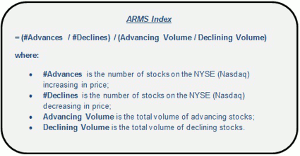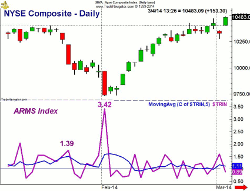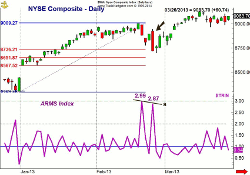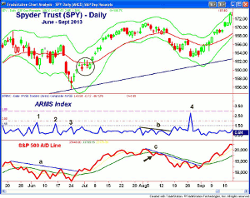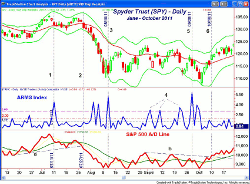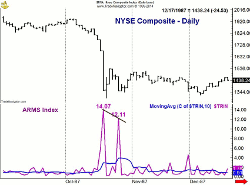Given the recent market action, technician Tom Aspray has decided to revisit a certain tool he first introduced in March of 2014 which has always helped him identify key turning points and is one that has also been one of his go-to indicators.
The selling on Monday, February 3, 2014 started overseas as the Spyder Trust (SPY) opened lower and continued to drop throughout the day settling at $174.17, which was 2.2% below the prior Friday’s close.
The range in the futures reflected even more violent selling as they opened Sunday night at 1777.50 and hit a low of 1732.25. The intra-day range was a whopping 51.5 points as the liquidation was relentless. There had been a similar sharp drop on January 24 of that year, as the decline in the emerging markets currencies triggered an initial wave of selling.
On that Friday, the S&P futures lost 33.7 points and made a short-term low early the following day as the futures stabilized for the four days. Those who established short positions as prices moved sideways were rewarded by the plunge on February 3, but how many on the short side took profits that day?
I am sure some did but many instead were expecting stocks to plunge further throughout the week possibly doubling their already sizable profits. They were likely dismayed when the SPY actually closed the week higher. Those who were still holding short positions likely had a sick feeling in the pit of their stomach.
Many years ago when I was a more active trader on both the long and short side of the market, I experienced this feeling and it was not fun. There was one indicator that I began to rely on to help tell me when the selling had reached panic levels. It was the Arms Index developed in 1967 by Richard Arms. It is now known by many as the Trin. The formula is pretty straightforward.
Dick has written The Arms Index (Trin Index): An Introduction to Volume Analysis, as well as many excellent books on technical analysis.
In the early days of financial TV, I tried to argue that they should refer to this indicator as the Arms Index out of respect to Dick. Unfortunately, I was unsuccessful but several years later had the pleasure of traveling throughout Asia with Dick, and his lovely wife, June.
The chart above of the NYSE Composite shows that the Arms Index closed at 3.42 on February 3, 2014 and was even higher during the day. This was a clear sign that the volume of selling was extreme and could have warned those on the short side not to be greedy and instead to take some profits.
On the January 24, 2014 drop, the Arms Index closed at 1.39. The 1.40 area was always a level that suggested to me that the sellers might have been taking over. When the readings of the Arms Index get to three or much higher, it starts to suggest that you may be near a selling climax. The blue line is a 10-day MA of the Arms Index, which had risen to 1.48 on February 3 of last year.
In this trading lesson, I would like to share some examples of how the Arms Index can be quite helpful in identifying panic lows, as well as buying opportunities when the market is in a rally phase.
NEXT PAGE: Other Indicators to Use with Arms Index
|pagebreak|This second chart of early 2013 shows the powerful rally that began on the last day of 2012 and carried over until the latter part of February. After the higher close on February 19, stocks got hammered the next day in reaction to disappointing economic data and concerns over the EuroZone. The high-flying stocks were hit hard with Tesla (TSLA) losing 9%.
On February 20, the Index closed at 2.99. Three days later, as stocks dropped even further (see arrow), the Arms index closed at 2.87. This indicated that the selling pressure was not as high, even though prices were lower. This bullish divergence (line a), given the bullish action of the A/D line, suggested that the worst of the decline might be over.
The NYSE Composite made its low on February 26 at 8700.73, which was just below the 38.2% Fibonacci support from the late-December low but above the 50% support at 8651. As discussed previously in Finding High-Probability Entry Levels, a drop between these two support levels is often where a correction in an uptrend will end.
In conjunction with extreme readings in the Arms Index, one needs to analyze action in the Advance/Decline line. This chart covers the decline from the May 22 high in 2013 that lasted just four weeks. The first wave of selling took the SPY down to $158.55 as it came close to its starc- band. The Arms Index had closed at 1.85 (point 1), and then the following day, hit 2.43 intra-day before closing at 0.70.
As is typically the case when the starc- bands are reached, the SPY did rebound. The action over the next nine days was choppy, as on one down day, the Arms Index spiked to 1.71 (point 2). The selling soon resumed, but even after four consecutive days on the downside, the Arms Index could only make it to 1.38 (point 3) while the SPY closed just above its starc- band.
Only two days after this low, the S&P 500 Advance/Decline moved back above its 21-day WMA and the following day its downtrend, line a, was broken. This was a bullish sign and the consolidation in early July (see circle) above the 3rd quarter pivot of $159.58 was a good buying opportunity.
The A/D line stayed above its WMA until August 7 as it dropped below the WMA and the prior low (see arrow). This was a sign of weakness, and after moving sideways for a few days above its 20-day EMA, the SPY gapped lower. This pushed the Arms Index above its pattern of lower highs, line b, and a few days later it hit a high of 1.40.
The SPY rallied from its starc- band back to the 20-day EMA before gapping to the downside on August 27 when the Arms Index closed at 2.79 (point 4). Just four days later on September 3, the A/D line broke its downtrend, line c, and soon moved back above its WMA suggesting the correction was over.
Of course, the patterns and signals are not always so clear and the decline from the September 14, 2012, high to the November 16 low was one of the more challenging corrections. The SPY had closed at its daily starc+ band that day (point 1) and Apple, Inc. (AAPL) spiked to a new high and formed a doji. A low close doji sell signal was triggered the following day.
NEXT PAGE: Arms Index Reflected the Political News
|pagebreak|The wave of selling lasted eight days as the SPY dropped down to test its starc- band on September 26. The previous day (line 2) the Arms Index spiked to 2.90. During the eight-day rally that followed, the SPY came close to the old highs as the Index dropped to 0.60. The rally was not broadly based as former market leader AAPL just continued to drop.
After another market decline and a further rally, the SPY dropped below its starc- band on October 23 as the Arms Index closed at 2.96 with an intra-day high of 3.74 (line 3). Stocks tried to move higher until the election as the Index dropped back to the 0.60 level before the sellers again took over as the SPY gapped lower on November 7 (line 4).
The Arms Index closed the day at 2.35 with a high of 2.94. The SPY continued to decline as it lost another 3.6% making an intra-day low at $134.70 on November 16. This was accompanied by a close in the Index of 1.32 with an intra-day high of 2.40. The lower highs in the Arms Index (line a) indicated that fewer sellers were pushing prices lower. This is typically what you see when the selling pressure is being exhausted.
The A/D line was able to move through its downtrend, line b, just four days after the low, which demonstrated the high level of buying that was pushing stocks higher. On December 12, 2012, the NYSE Advance/Decline made a new bull market high, which was followed a few days later by a new high in the S&P 500 A/D line (point 5).
On the sharp drop in reaction to the apparent failure to avoid the fiscal cliff, the Arms Index had twin spikes above the 2.00 level (point 6) as SPY again tested its starc- band. The new high in the A/D line identified this as a buying opportunity and the oversold readings from the Arms Index provided a low-risk entry.
The failure to reach a meaningful budget deal in the summer of 2011 also shook the financial markets and caused a steep drop in the stock market. The market had rebounded from the June lows but the first batch of heavy selling occurred on July 11, 2011 as the Arms Index closed at 4.42 (line 1).
The A/D line was still above its WMA but did drop below it three days later as the Arms Index rose back to 1.50 indicating that selling pressure was building. On July 27, 2011 (line 2), the A/D line violated the support at line a and began to decline more sharply.
By early August, the SPY had been hugging the starc- band for several days, the Arms Index closed at 4.39 on August 2 and two days later was back to 4.11. Back-to-back readings at this high level typically suggest that you have reached a selling climax or are very close.
With the SPY below both its daily and weekly starc band, the Index closed at 5.22 (line 3) as the market was hit by a final wave of selling in reaction to the downgrade of US debt. Over the next month, the SPY developed a broad trading range as some analysts had concluded that we were going to see a double-dip recession.
On three instances (point 4), the Arms Index spiked above the 3.00 level with the highest reading of 3.60 on September 21, 2011. This was a sign that the market was absorbing some heavy selling. The fact that the A/D lines had confirmed the April highs sent a strong message that the stock market’s major trend was still positive. The SPY again bounced from its starc- band over the next few days closing just barely above its 20-day EMA.
NEXT PAGE: Uses of Arms Index on Options and ETFs
|pagebreak|The next day, another wave of selling hit the market as the Arms Index hit an intra-day high of 7.17 and then closed at 5.83 (line 5). A secondary peak at 3.97 was formed two days later as the SPY dropped below the starc- band on October 4 before reversing to close the day higher.
This was consistent with a sold-out market as the A/D lines did not make new lows with prices. There were still some sellers out there as three days after the lows the Arms Index closed at 1.50 and the next day (line 5) the A/D line broke through its resistance at line b. This was a strong buy signal as noted a few days later in Be Bold, Be Fearless…Buy the Dip.
Though I concentrated on examples during the most recent bull market, I have observed the same patterns for many years. This chart covers the 1987 crash, which began in early October of 1987. On October 13, the Index closed at 0.39 as the NYSE Composite finished the day at 1861. The next day, the Index had risen to 1.88 indicating increasing volume on the sell side.
Stocks closed sharply lower on Friday and then massive liquidation hit the futures market before Monday’s opening. The NYSE Composite ended the day at 1375 with an Arms Index reading at 14.07. This was a decline of over 26% in just four days. The next day, the NSYE Composite made a new intra-day low before closing higher as the Index dropped to 0.27.
The NYSE Composite made a new closing low on October 26, which was accompanied by an Arms Index reading of 12.11. The lower highs, line a, was a bullish divergence and was consistent with a sold-out market.
In order to incorporate the Arms Index into your trading or investing, take a look at the advance/decline data and advancing/declining volume on any day you see a substantial price move, especially when the market closes lower.
When you observe spikes in the Arms Index and the A/D line is flat or in a short-term downtrend, then such a reading is more likely to be a warning. For those of you who buy options or leveraged ETFs, very high Arms Index readings with prices at the starc- bands are a sign that you should wait before buying puts or inverse ETFs. The odds will favor a rebound in the downtrend, and therefore, a better entry level.
If you get a series of high readings in the Arms Index that are accompanied by bottoming action in the A/D lines, one can look for a buying opportunity. Orders well under the market can be used only when it is possible to use a reasonable stop.
Call option prices often crash when the Arms Index is high as any premium often evaporates. For example, a weekly SPY March 187 call traded on Friday, February 28, 2014 at around $1.40, but dropped under $0.40 on Monday, March 3rd’s decline. In Thursday's session (3/6/14), it was back to $1.70.
In my analysis, I have found very low readings of the Arms Index to be less useful, though a 10-day moving average can help one identify when the market is overbought, especially if accompanied by a high reading in the McClellan oscillator. Trendline analysis can also be helpful.
I hope you will take a further look at the Arms Index, as well as some of the other excellent work that Richard Arms has contributed to the field of technical analysis.

